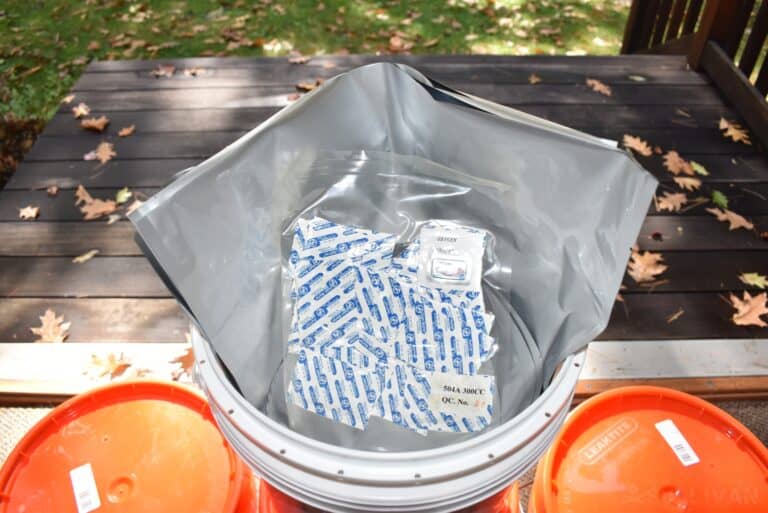Long-term food storage is on the forefront of every prepper and survivalist’s mind throughout the year.

Whether taking advantage of a sale or filling your emergency stock, the premise remains the same, keeping a large amount of food safe to eat for long periods of time.
Mylar bags have been a popular choice for decades among food storage enthusiasts.
These hybrid plastic, foil bags are often referred to as the best way to keep out air, light, heat, moisture, and insects from your food.
Common ingredients such as flour can spoil quickly or become a host for weevils if not stored properly.
Mylar bags are one of the best ways to store your flour long-term. You can expect a shelf life spanning years instead of the meager 6-12 months you will get with an airtight container.
If you’re looking for a way to prolong the life of your flour then keep reading to learn how mylar bags are a great method for you to try.
Why Would You Use Mylar to Store Flour?
All-purpose flour has a short shelf life mainly due to the packaging that is sold in.
The paper bag provides minimal protection against the destroyers of food, mainly:
- Oxygen
- Light
- Heat
- Moisture
- Insects
This is primarily why the flour left in your pantry will go bad as it is exposed to all of these elements.
Whole grain flour has an even less shelf life since it contains a lot of oils that can quickly go rancid in the wrong conditions.
Mylar bags consist of layers of plastic and foil that create a perfect seal from the outside world.
Some manufacturers will use plastic with a sprayed coating but these can often be considered cheaper than the multi-layered bags.
The metal core of the bag is what prevents the light and air from penetrating the material.
One of the important steps is to vacuum seal it and get rid of that pesky oxygen that can get in.
Afterward, you’ll need to heat seal the bag to make sure that there are no entry points for problems.
How Do Oxygen Absorbers Help?
The cherry on top of this process is to throw oxygen absorbers into the mylar bags prior to sealing them.
These little packets are filled with iron shavings that turn to rust when exposed to oxygen.
As this reaction is happening, nitrogen is released into the bag which is an inert gas that doesn’t affect the food.
The safety concerns regarding oxygen absorbers are minimal since all it contains is iron shavings.
If the oxygen absorber is damaged in any way then simply discard it as you don’t want iron shavings in your food.
Oxygen absorbers actually make the food safer to eat since companies don’t need to use preservatives such as BHT, BHA, and sulfur dioxide.
If you’re looking to improve the shelf life of your food then an oxygen absorber essentially puts the contents of the bag into suspended animation.
What is The Storage Life of Flour?
Flour is one of those ingredients that can have the end of its shelf life sneak up on you if you’re not using it frequently.
I remember going to the pantry and smelling musty flour before realizing that I had that bag for at least 8 months.
Since flour is susceptible to many common food storage problems it is ideal to move it from its original packaging into something meant for longer storage.
Does Flour Expire?
Flour has a short expiration date that is hastened by being exposed to bugs and moisture. In the original packaging, unopened, you can expect up to 12 months of storage time.
Sealed in an airtight jar you will get about the same amount of time but insects and moisture will be barred from entry.
Unfortunately, with whole grain flours you generally have to eat them quicker since they tend to break down easier than white flour.
When stored in a Mylar bag the absence of all of these factors can get you several years of storage out of your flour.
It is best to avoid storing whole grain flour in mylar bags for long-term storage since they do have a lot of oils that will go bad.
Optimal Storage Conditions
Keeping your flour in the basement or cellar may not be the best conditions for it to stay fresh longer. There are four main factors that need to be addressed for optimal storage. These are:
- The temperature should stay below 70 degrees Fahrenheit (21 Celsius) with minimal fluctuations for long periods of time.
- Ideally, you should keep the flour in a dark and dry location
- Store it off the floor since condensation can build up underneath if there is contact with the floor
- If you can store the Mylar bags in a metal container or a food-grade storage container it will keep rodents away from them.
Should You Store Flour in The Freezer?
Storing flour in the freezer is another great way to increase the shelf life of your flour.
One of the common downsides to this kind of preservation is that if the electricity goes out and your freezer defrosts it can create a host of issues with your food.
If you don’t defrost the flour properly then it will cause moisture to build up in the bag and then the flour is ruined.
However, flash-freezing your flour before preserving it in Mylar bags is a great way to make sure that no insects have made their way into it.
Can Insects or Bugs Live in Flour?
If you’ve been using flour for a long time then you’ve heard of weevils. For weeks your flour is seemingly fine and then out of nowhere, there are these little worms moving around in the flour.
Eventually, they turn into little flying moths and you’ll see them flitting around your kitchen looking for more flour to lay eggs in.
The life cycle of these insects is interesting because the eggs need to sit for a few weeks before they hatch.
This means that you won’t even know you have a weevil infestation until it’s too late. That is unless you freeze your flour beforehand.
Vacuum sealing the bag will do the trick too since nothing can live without oxygen.
Just be sure to check your flour before consumption in case there are some dead insects in it.
Pros and Cons of Storing Flour in Mylar Bags
If you’re still mulling over the idea of storing your food in Mylar bags here are some pros and cons to help you out.
| Pros | Cons |
|---|---|
| Incredibly long shelf life | Equipment is expensive |
| Protects against pests and the elements | Potential for bag defects |
| An easy enough process | Can’t do it without electricity |
| Great value if you store a lot of food |
Speaking a little more towards bag defects as a con. Much like dented cans, punctured or creased mylar bags have a weakened structural integrity.
These are excellent windows for things like air and moisture to sneak their way into the bag.
A tell-tale sign that your Mylar bag has air in it is if it has lost the vacuum seal and the bag itself has puffed out.
This means the food is compromised and if you catch it quickly enough, can be repackaged and heat-sealed.
If you think your food has been compromised by a damaged vessel, it is best to discard it unless you are 100% sure it hasn’t spoiled.
Tips On Storing Your Flour in Mylar Bags
While the method is straightforward, there are some nuances that you’ll want to pay attention to. The following are some of the top tips for storing food in mylar bags.
Freeze your flour up to two days before storing – This will kill all the insects that are lurking inside. Make sure you don’t let the flour get wet while defrosting.
Work quickly before the oxygen absorbers lose effectiveness – Even the best oxygen absorbers can start to work less efficiently within a half hour so you want to get those bags sealed up as quickly as possible.
Final Thoughts
Mylar bags offer a level of protection that is lightweight, durable, and capable of keeping food safe to eat for several years.
In an age where food security can be changed in a short time, having a plan in place to store staples such as flour is as important as a bug out plan.
Frequently Asked Questions
New to long-term food storage? The answers to these questions might help you out.
If moisture gets into your flour then you can expect mold, especially if it’s in a humid environment. Keep the flour in a cool and dry place.
Storing flour in the fridge is a great way to deter insects from getting into it. Be sure to keep it at the back of your fridge at the top shelf since cold air loves to fall.
The expiration date of flour depends on the type of and the storage conditions it was kept in.
White flour generally will keep in the original packaging for about 12 months where you will have around 10 months for whole grain flour.
You can heat seal your mylar bags with a common household iron. Oxygen absorbers are integral in keeping air out of the packaging.
If you find mylar bags that are able to be fully vacuum sealed this is an additional benefit.

Perrin is an adventure guide and naturalist currently living a nomadic life in the Canadian wilderness. His education and expertise is in wilderness survival and wildlife tracking. He enjoys teaching people about the outdoors and has managed large groups on expeditions.
With several accredited certifications, including being a wilderness first responder and a leave no trace expert, Perrin believes it is important for all of us to reconnect with the natural world.
